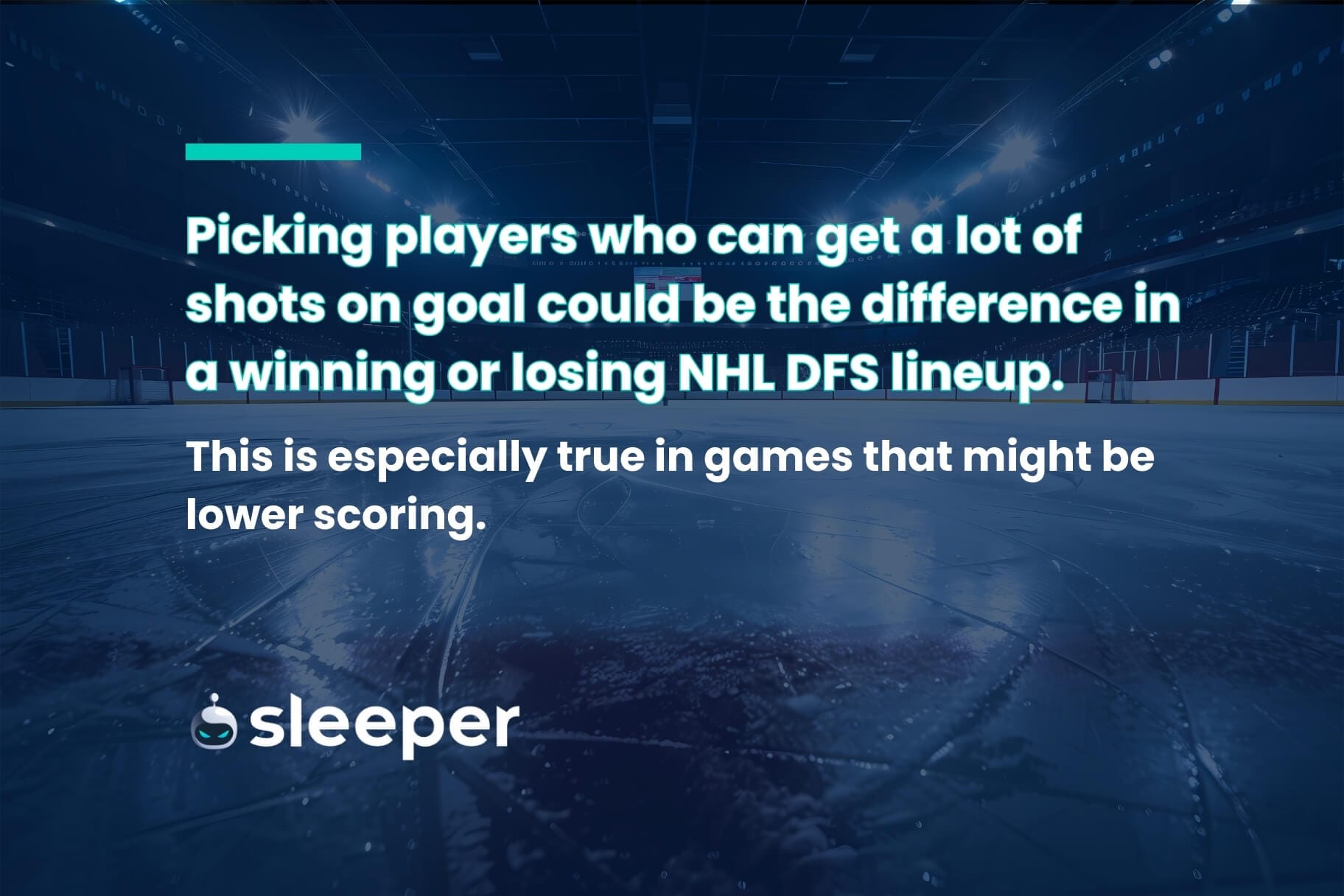Daily fantasy sports are a great way to enjoy pro hockey and get a piece of the action. Find out which NHL DFS strategies will help you cash in.

NHL DFS Strategy: Everything You Need to Know
The popularity of daily fantasy sports (DFS) has grown exponentially over the years, and that includes hockey DFS. NHL DFS is just one of the ways you can get in on the action for a single game, small slate or full slate of games on any given night.
Want to start building winning NHL DFS lineups? You’ve come to the right place. In this article, we’ll break down everything you need to know to get an edge, from understanding the scoring system to selecting the right players and building solid lineups. Whether you're a seasoned player or just starting out, these tips will help you stay ahead of the competition.
NHL DFS Scoring Basics and Rules
The scoring system used in NHL DFS is pretty straightforward, but each different DFS platform has its own quirks.
Typically, points are awarded for goals, assists, shots on goal, blocked shots and other performance metrics for skaters. Goalies usually earn points for every save, a win, and can earn extra points for a saves bonus. Of course, there are negative points for goals against and a loss.
It’s important to understand how your specific DFS platform’s scoring system works. This may alter your strategy when building a lineup if a certain NHL DFS platform inflates or deflates the value or some stats or has bonuses for reaching shots on goal, points or saves milestones.
Read More: Sleeper Picks Scoring Stats Explained
Top 5 Best NHL DFS Strategies
There are a variety of strategies you can use when drafting your NHL DFS team. We’ll explore some of the best ones here.
1. Line Stacking
Stacking in daily fantasy sports is nothing new. Many players of other sports, such as NFL DFS, are familiar with the strategy of stacking. For hockey DFS, stacking skaters who play on the same line is a valuable strategy to use.
The most valuable stats in NHL DFS are goals, assists and shots on goal. If a forward scores a goal, that goal is likely to be assisted by his linemates. So instead of just getting however much a goal is worth, you have a much better chance of earning secondary points via an assist as well if you abide by the stacking philosophy.
Line stacking is useful in a few different ways. You can pair a top star with a lower-cost winger, two high-cost skaters or two low-cost skaters if you’re looking for a budget duo.
The best use of line stacking is typically with a team’s first line or second line, as those trios get the most ice time and usually have the best players.

2. Power-Play Units
On top of stacking a single line, it’s also important to stack skaters who play on the same power-play unit. Power plays account for a decent portion of goals scored for most teams. Having a man advantage allows for the best players to score and earn your NHL DFS points.
The interesting thing about building a lineup with a power-play unit is that sometimes skaters lower down in the lineup are on the top unit. That allows you to potentially save some salary while building a lineup with a power-play unit.
It’s best to use this strategy for teams with the best power play in the leagues or against teams with poor penalty-killing units. But don’t limit yourself to that. Even the worst teams in the league are capable of scoring on the power play.
3. High Shot Volume Players
While it’s important to look at players who rack up NHL points (goals and assists), some of the most overlooked skaters are those who take a lot of shots on goal. Depending on your hockey DFS platform, a few shots on goal can be just as valuable as a goal or an assist.
There are also a few NHL DFS platforms that offer bonuses for any player who reaches at least five shots on goal. This kind of format makes it extra important for skaters who take a lot of shots on goal.
Especially in games that might be lower scoring, picking players who can get a lot of shots on goal could be the difference in a winning or losing NHL DFS lineup.
4. Matchups Against Weak Goalies
As with any daily fantasy sports lineup, it’s important to look for players who are facing weaker opponents. For hockey DFS, this means picking against some of the weaker goalies in the league.
Weaker goalies may allow just a goal or two more than others, but those extra points are crucial. Stacking against a weak goalie can be an extra valuable picking strategy, as you can earn fantasy points for goals, assists and shots on goal against him.
5. Exposure to Multiple Lines & Power-Play Units
When stacking lines and power-play units, take a look at building a lineup across multiple lines.
For example, take a group of three players. They all play on the top power-play unit, and two of them play together on the top line while the other is on the second line. That gives you a power-play stack as well as exposure to both of the top lines at even strength.
You could also stack three players from the same line who play on different power-play units. That would give you a complete line at even strength as well as exposure to both power-play units.

Best Tips for Successful NHL DFS
Here are a handful of additional tips that will help you build a successful NHL DFS lineup.
Research line combinations and player roles
Knowing which skaters play on specific lines are key. While teams can keep lines together for long stretches throughout the season, others may change things up depending on injuries or streakiness from players.
It is crucial to know not only who is playing on what line but also what their role might be on that line.
For example, if a player who usually takes a lot of shots on goal while playing on the third or fourth line is moved up to the first or second line, he may look like a good option. However, he may not get as many shooting opportunities while playing more of a support role with better linemates.
That doesn’t mean that that player is a bad option, though, as he theoretically has a better chance of getting a goal or an assist.
Correlate your goalies
Given the nature of NHL DFS scoring, you don’t want to draft a goalie that is playing against a team whose line you stacked. If you have a few skaters from one team, you want them to score. You don’t want them to score against your goalie.
It is sometimes beneficial to correlate your goalies with skaters, assuming that successful games from skaters will lead to a better chance of the goaltender picking up a win.
Pay up at defense
It can be enticing to find some bargain bin players on the blue line, but paying up for defensemen can be an important tip for NHL DFS.
Defensemen have the extra bonus of not only potentially getting points for goals, assists and shots on goal, but blocked shots as well. Some NHL DFS platforms even offer bonuses for multiple blocked shots.
Avoid overloading on high-risk players
You may want to take down a big tournament, but having too many high-risk players isn’t the way to go. You should look to build your lineup with a solid mix of players with high ceilings as well as high floors.
For example, there are some skaters who have a lot of goals and assists but do not shoot the puck enough and rarely block shots. Try to pair those higher-risk players with lower-risk shooters and defensemen who will have at least a handful of shots on goal and potentially some blocked shots as well. This is especially important on those bonus NHL DFS platforms.

Frequently Asked Questions
How do you win big in DFS?
You can win big in NHL DFS by playing some of the bigger guaranteed prize pool (GPP) tournaments. The percentage of entrants paid is lower, but the prizes are much higher if you can bink on a lineup.
What are the best stats to look at for NHL DFS?
It’s important to look at shots on goal and blocked shots for NHL DFS, along with goals, assists and points, of course. For goalies, look for teams who allow a lot of shots so the goaltenders can rack up saves.
How do I choose the right players for NHL DFS?
You can choose the right players for NHL DFS by reading this guide for important strategies and tips. Furthermore, look for players who shoot a lot and are playing against weaker opponents.
Is it better to stack lines in NHL DFS?
Yes, it is better than not to stack lines in NHL DFS. It’s key to stack a few players in your lineup in an attempt to maximize your points.
Can I win consistently at NHL DFS?
If you’re looking to win consistently at NHL DFS it is important to play cash games as well as GPP tournaments. Manage your risk and mix your lineup with a variety of strategies.
Elevate Your NHL DFS Game With These Strategies
You should now know the most important NHL DFS strategies to build successful lineups. Stack, look at power play units and opponents and mix your high-risk players with low-risk players.
Using Sleeper Picks for DFS has many benefits such as up-to-date player news, advanced stats and community insights. You can join by signing up on the website or downloading the app on your mobile device.




